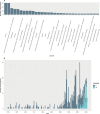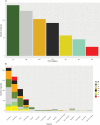Beyond the species name: an analysis of publication trends and biases in taxonomic descriptions of rainfrogs (Amphibia, Strabomantidae, Pristimantis)
- PMID: 36761112
- PMCID: PMC9836588
- DOI: 10.3897/zookeys.1134.91348
Beyond the species name: an analysis of publication trends and biases in taxonomic descriptions of rainfrogs (Amphibia, Strabomantidae, Pristimantis)
Abstract
The rainfrogs of the genus Pristimantis are one of the most diverse groups of vertebrates, with outstanding reproductive modes and strategies driving their success in colonizing new habitats. The rate of Pristimantis species discovered annually has increased continuously during the last 50 years, establishing the remarkable diversity found in this genus. In this paper the specifics of publications describing new species in the group are examined, including authorship, author gender, year, language, journal, scientific collections, and other details. Detailed information on the descriptions of 591 species of Pristimantis published to date (June 2022) were analyzed and extracted. John D. Lynch and William E. Duellman are the most prolific authors, yet Latin American researchers have scaled up and continued the description processes since the 1990s. The most common language used for descriptions is English, followed by Spanish. The great majority of authors have described only one species. The largest proportion of authors who have participated in the descriptions is of Ecuadorian nationality. Ecuador is the country with the highest description rate per year (3.9% growth rate). Only 20% of the contributions have included women and only 2% have featured women as principal authors. 36.8% of the species described are in the Not Evaluated or Data Deficient categories under the IUCN global red list. The importance of enhancing the descriptions in Spanish is emphasized and the inclusion based on equal access to opportunities for female researchers in Pristimantis taxonomy is encouraged. In general, if the current trends in Pristimantis descriptions continue, in ten years, a total of 770 or more species described could be expected.
ResumenLas ranas de la lluvia del género Pristimantis es uno de los grupos de vertebrados más diversos, con una variedad de modos reproductivos y estrategias que impulsan su éxito en la colonización de nuevos hábitats. La tasa de especies de Pristimantis descubiertas anualmente ha aumentado continuamente durante los últimos 50 años, estableciendo la notable diversidad encontrada en este género. En este artículo, examinamos los detalles de las publicaciones que describen nuevas especies en el grupo, incluida la autoría, el año, el idioma, la revista, el género, las colecciones científicas y otros detalles. Analizamos y extrajimos información detallada sobre las descripciones de 591 especies de Pristimantis publicadas hasta la fecha (junio 2022). John D. Lynch y William E. Duellman son los autores más prolíficos, pero los investigadores latinoamericanos han ampliado y continuado los procesos de descripción desde la década de 1990. El idioma más común utilizado para las descripciones es el inglés, seguido del español. La gran mayoría de los autores han descrito una sola especie. La mayor proporción de autores que han participado en las descripciones es de nacionalidad ecuatoriana. Ecuador es el país con la tasa de descripción más alta por año (tasa de crecimiento del 3,9%). Solo el 20% de las contribuciones han incluido a mujeres y solo el 2% las ha presentado como autoras principales. El 36,8% de las especies descritas se encuentran en las categorías No evaluadas o Datos insuficientes de la lista roja mundial de la UICN. Destacamos la importancia de potenciar las descripciones en español y fomentar la inclusión de mujeres investigadoras en la taxonomía de Pristimantis. En general, si continúan las tendencias actuales en las descripciones de Pristimantis, en 10 años se podría esperar un total de 770 o más especies descritas.
Keywords: Author gender; herpetology; inclusion; language bias; new species; taxonomy.
Carolina Reyes-Puig, Emilio Mancero.
Figures









Similar articles
-
High speciation in the cryptic Pristimantis celator clade (Anura: Strabomantidae) of the Mira river basin, Ecuador-Colombia.PeerJ. 2025 Jan 29;13:e18680. doi: 10.7717/peerj.18680. eCollection 2025. PeerJ. 2025. PMID: 39897485 Free PMC article.
-
Six new species of Pristimantis (Anura: Strabomantidae) from Llanganates National Park and Sangay National Park in Amazonian cloud forests of Ecuador.PeerJ. 2022 Oct 17;10:e13761. doi: 10.7717/peerj.13761. eCollection 2022. PeerJ. 2022. PMID: 36275471 Free PMC article.
-
Unveiling the evolutionary relationships and the high cryptic diversity in Andean rainfrogs (Craugastoridae: Pristimantis myersi group).PeerJ. 2023 Mar 1;11:e14715. doi: 10.7717/peerj.14715. eCollection 2023. PeerJ. 2023. PMID: 36879909 Free PMC article.
-
The advertisement calls of Brazilian anurans: Historical review, current knowledge and future directions.PLoS One. 2018 Jan 30;13(1):e0191691. doi: 10.1371/journal.pone.0191691. eCollection 2018. PLoS One. 2018. PMID: 29381750 Free PMC article. Review.
-
Taxonomic revision of Physalis in Mexico.Front Genet. 2023 Apr 14;14:1080176. doi: 10.3389/fgene.2023.1080176. eCollection 2023. Front Genet. 2023. PMID: 37124620 Free PMC article. Review.
Cited by
-
Two new species of terrestrial frogs of the Pristimantisgladiator complex (Anura, Strabomantidae) from the Ecuadorian Andes, with insights on their biogeography and skull morphology.Zookeys. 2023 Sep 26;1180:257-293. doi: 10.3897/zookeys.1180.107333. eCollection 2023. Zookeys. 2023. PMID: 38312322 Free PMC article.
-
High speciation in the cryptic Pristimantis celator clade (Anura: Strabomantidae) of the Mira river basin, Ecuador-Colombia.PeerJ. 2025 Jan 29;13:e18680. doi: 10.7717/peerj.18680. eCollection 2025. PeerJ. 2025. PMID: 39897485 Free PMC article.
-
A new cryptic species of terrestrial breeding frog of the Pristimantisdanae Group (Anura, Strabomantidae) from montane forests in Ayacucho, Peru.Zookeys. 2023 Dec 20;1187:1-29. doi: 10.3897/zookeys.1187.104536. eCollection 2023. Zookeys. 2023. PMID: 38161710 Free PMC article.
References
-
- Armesto LO, Señaris JC. (2017) Anuros del norte de los andes: Patrones de riqueza de especies y estado de conservación. Papéis Avulsos de Zoologia (São Paulo) 57(39): 491–526. 10.11606/0031-1049.2017.57.39 - DOI
-
- Arroyo SB, Serrano-Cardozo VH, Ramírez-Pinilla MP. (2008) Diet, microhabitat and time of activity in a Pristimantis (Anura, Strabomantidae) assemblage. Phyllomedusa: Journal of Herpetology 7(2): 109–119. 10.11606/issn.2316-9079.v7i2p109-119 - DOI
-
- Boulenger GA. (1882) Catalogue of the Batrachia Salientias. Taylor and Francis, London, 256 pp.
LinkOut - more resources
Full Text Sources
